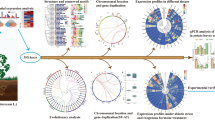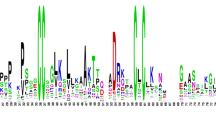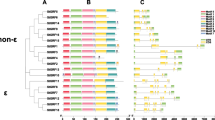Abstract
E2 (ubiquitin conjugating enzymes) is an important part of the ubiquitin–proteasome pathway. These enzymes have a significant role to play during plant growth and development, which can response to various stresses. To date, the E2 family has been reported in some high plants, but the genome-wide characterization of this gene family in potato remains unknown. In the present study, 57 putative StUBCs were identified, which were clustered into eight subgroups based on phylogeny. The introns varied in numbers 0 to 9. The highest numbers of introns were 5, which accounted for 31.57%. The analysis of gene duplication showed that 22 StUBC genes were involved in 13 segmental duplication events, while no tandem duplication was found in StUBC genes. According to gene ontology analysis (GO), StUBC family major function is protein binding and ion binding. The RNA sequencing data revealed that 15 StUBC genes were highly expressed in different organs and tubers. 27 StUBC genes were up-regulated under 50 µM ABA treatments. Moreover, the RNA-seq data and qRT-PCR analysis indicated that 17 StUBC genes responded to heat stress. 8 StUBC genes responded to salt stress according to qRT-PCR analysis, and StUBC2, StUBC12, StUBC30 and StUBC13 were predominant expression. The result of this research could provide valuable information to insight into potato E2 family and establish a foundation for further to elucidate function of E2 genes.








Similar content being viewed by others
References
Anithakumari AM, Nataraja KN, Visser RG et al (2012) Genetic dissection of drought tolerance and recovery potential by quantitative trait locus mapp ing of a diploid potato population. Mol Breed 30(3):1413–1429. https://doi.org/10.1007/s11032-012-9728-5
Bae H, Kim WT (2014) Classification and interaction modes of 40 rice E2 ubiquitin-conjugating enzymes with 17 rice ARM-U-box E3 ubiquitin lig-ases. Biochem Biophys Res Commun 444(4):575–580. https://doi.org/10.1016/j.bbrc.2014.01.098
Book AJ, Smalle J, Lee KH et al (2009) The RPN5 subunit of the 26 s proteasome is essential for gametogenesis, sporophyte development, and complex assembly in Arabidopsis. Plant Cell 21(2):460–478. https://doi.org/10.1105/tpc.108.064444
Cheng MC, Kuo WC, Wang YM et al (2017) UBC18 mediates ERF1 degradation under light-dark cycles. New Phytol 213(3):1156–1167. https://doi.org/10.1111/nph.14272
Chung E, Cho CW, So HA et al (2013) Overexpression of VrUBC1, a mung bean E2 ubiquitin-conjugating enzyme, enhances osmotic stress tolerance in Arabidopsis. PLoS ONE 8(6):e66056. https://doi.org/10.1371/journal.pone.0066056
Cui F, Liu L, Zhao Q et al (2012) Arabidopsis ubiquitin conjugase UBC32 is an ERAD component that functions in brassinosteroid-mediated salt stress tolerance. Plant Cell 24(1):233–244. https://doi.org/10.1105/tpc.111.093062
Diao Y, Li GL, Yu AQ et al (2016) Cloning and characterization of the UBC gene from lotus (Nelumbo nucifera). Genet Mol Res. https://doi.org/10.4238/gmr.15038341
Ding A, Marowa P, Kong Y (2016) Genome-wide identification of the expansin gene family in tobacco (Nicotiana tabacum). Mol Genet Genomics 291(5):1891–1907. https://doi.org/10.1007/s00438-016-1226-8
Dong C, Hu H, Jue D et al (2016) The banana E2 gene family: genomic identification, characterization, expression profiling analysis. Plant Sci 245:11–24. https://doi.org/10.1016/j.plantsci.2016.01.003
Gao Y, Wang Y, Xin H et al (2017) Involvement of ubiquitin-conjugating enzyme (E2 gene family) in ripening process and response to cold and heat stress of Vitis vinifera. Sci Rep 7(1):13290. https://doi.org/10.1038/s41598-017-13513-x
Glickman M, Ciechanover A (2002) The ubiquitin-proteasome proteolytic pathway: destruction for the sake of construction. Physiol Rev 82:373–428
Husnjak K, Dikic I (2012) Ubiquitin-binding proteins: decoders of ubiquitin-mediated cellular functions. Annu Rev Biochem 81:291–322. https://doi.org/10.1146/annurev-biochem-051810-094654
Ikeda F, Dikic I (2008) Atypical ubiquitin chains: new molecular signals. ‘Protein modifications: beyond the usual suspects’ review series. EMBO Rep 9(6):536–542. https://doi.org/10.1038/embor.2008.93
Jacobson AD, Zhang N-Y, Xu P et al (2009) The lysine 48 and lysine 63 ubiquitin conjugates are processed differently by the 26 s proteasome. J Biol Chem 284(51):35485–35494. https://doi.org/10.1074/jbc.M109.052928
Jones D, Crowe E, Stevens T et al (2001) Functional and phylogenetic analysis of the ubiquitylation system in Caenorhabditis elegans: ubiquitin-conjugating enzymes, ubiquitin-activating enzymes, and ubiquitin-like proteins. Genome Biol 3(1): research0002.0001–0002.0015
Jue D, Sang X, Liu L et al (2018) The ubiquitin-conjugating enzyme gene family in Longan (Dimocarpus longan Lour.): genome-wide identification and gene expression during flower induction and abiotic stress responses. Molecules. https://doi.org/10.3390/molecules23030662
Jue D, Sang X, Lu S et al (2015) Genome-wide identification, phylogenetic and expression analyses of the ubiquitin-conjugating enzyme gene family in maize. PLoS ONE 10(11):e0143488. https://doi.org/10.1371/journal.pone.0143488
Jue D, Sang X, Shu B et al (2017) Characterization and expression analysis of genes encoding ubiquitin conjugating domain-containing enzymes in Carica papaya. PLoS ONE 12(2):e0171357. https://doi.org/10.1371/journal.pone.0171357
Kim DY, Scalf M, Smith LM et al (2013) Advanced proteomic analyses yield a deep catalog of ubiquitylation targets in Arabidopsis. Plant Cell 25(5):1523–1540. https://doi.org/10.1105/tpc.112.108613
Kornitzer D, Ciechanover A (2000) Modes of regulation of ubiquitin-mediated protein degradation. J Cell Physiol 182:1–11
Kraft E, Stone SL, Ma L et al (2005) Genome analysis and functional characterization of the E2 and RING-type E3 ligase ubiquitination enzymes of Arabidopsis. Plant Physiol 139(4):1597–1611. https://doi.org/10.1104/pp.105.067983
Lin Y, Hwang WC, Basavappa R (2002) Structural and functional analysis of the human mitotic-specific ubiquitin-conjugating enzyme, UbcH10. J Biol Chem 277(24):21913–21921. https://doi.org/10.1074/jbc.M109398200
Livak KJ, Schmittgen TD (2001) Analysis of relative gene expression data using real-time quantitative PCR and the 2(-Delta Delta C(T)) method. Methods 25(4):402–408. https://doi.org/10.1006/meth.2001.1262
Loon CDV (1981) The effect of water stress on potato growth, development, and yield. Stress Physiol Symp 58:51–69
Lynch M, Conery J (2000) The evolutionary fate and consequences of duplicate genes. Science 290:1151–1155
Michelle C, Vourc’h P, Mignon L et al (2009) What was the set of ubiquitin and ubiquitin-like conjugating enzymes in the eukaryote common ancestor? J Mol Evol 68(6):616–628. https://doi.org/10.1007/s00239-009-9225-6
Millyard L, Lee J, Zhang C et al (2016) The ubiquitin conjugating enzyme, TaU4 regulates wheat defence against the phytopathogen Zymoseptoria tritici. Sci Rep 6:35683. https://doi.org/10.1038/srep35683
Mullins E, Milbourne D, Petti C et al (2006) Potato in the age of biotechnology. Trends Plant Sci 11(5):254–260. https://doi.org/10.1016/j.tplants.2006.03.002
Nakagawa T, Nakayama K (2015) Protein monoubiquitylation: targets and diverse functions. Genes Cells 20(7):543–562. https://doi.org/10.1111/gtc.12250
Olga Gorlova A, Fedorov C, Logothetis et al (2014) Genes with a large intronic burden show greater evolutionary conservation on the protein level. BMC Evol Biol 14:50. http://www.biomedcentral.com/1471-2148/14/50
Özkan E, Yu H-T, Deisenhofer J (2005) Mechanistic insight into the allosteric activation of a ubiquitin-conjugating enzyme by RING-type ubiquitin ligases. Proc Natl Acad Sci USA 102:18890–18895. https://doi.org/10.1073/pnas.0509418102
Peng J, Schwartz D, Elias E et al (2003) A proteomics approach to understanding protein ubiquitination. Nat Biotechnol 21:921–926
Potato Genome Sequencing Consortium, Xu X, Pan S et al (2011) Genome sequence and analysis of the tuber crop potato. Nature 475(7355): 189–195. https://doi.org/10.1038/nature10158
Ramadan A, Nemoto K, Seki M et al (2015) Wheat germ-based protein libraries for the functional characterisation of the Arabidopsis E2 ubiquitin conjugating enzymes and the RING-type E3 ubiquitin ligase enzymes. BMC Plant Biol 15:275. https://doi.org/10.1186/s12870-015-0660-9
Ramsey J, Schemsk D (1998) Pathways, mechanisms,and rates of polyploid formation in flowering plants. Annu Rev Ecol Syst 29:467–501
Ryu MY, Cho SK, Kim WT (2010) The Arabidopsis C3H2C3-type RING E3 ubiquitin ligase AtAIRP1 is a positive regulator of an abscisic acid-dependent response to drought stress. Plant Physiol 154(4):1983–1997. https://doi.org/10.1104/pp.110.164749
Sharma B, Bhatt TK (2017) Genome-wide identification and expression analysis of E2 ubiquitin-conjugating enzymes in tomato. Sci Rep 7(1):8613. https://doi.org/10.1038/s41598-017-09121-4
Sung P, Prakash S, Prakash L (1990) Mutation of cysteine-88 in the Saccharomyces cerevisiae RAD6 protein abolishes its ubiquitin-conjugating activity and its various biological functions. Proc Natl Acad Sci USA 87:2695–2699
Tang X, Zhang N, Si H et al (2017) Selection and validation of reference genes for RT-qPCR analysis in potato under abiotic stress. Plant Methods 13:85. https://doi.org/10.1186/s13007-017-0238-7
Trapero-Mozos A, Ducreux LJM, Bita CE et al (2018) A reversible light- and genotype-dependent acquired thermotolerance response protects the potato plant from damage due to excessive temperature. Planta 247(6):1377–1392. https://doi.org/10.1007/s00425-018-2874-1
Wan X, Mo A, Liu S et al (2011) Constitutive expression of a peanut ubiquitin-conjugating enzyme gene in Arabidopsis confers improved water-stress tolerance through regulation of stress-responsive gene expression. J Biosci Bioeng 111(4):478–484. https://doi.org/10.1016/j.jbiosc.2010.11.021
Wang S, Cao L, Wang H (2016) Arabidopsis ubiquitin-conjugating enzyme UBC22 is required for female gametophyte development and likely involved in Lys11-linked ubiquitination. J Exp Bot 67(11):3277–3288. https://doi.org/10.1093/jxb/erw142
Wang Y-Y, Wang W-H, Cai J-H et al (2014) Tomato nuclear proteome reveals the involvement of specific E2 ubiquitin-conjugating enzymes in fruit ripening. Genome Biol 15:548. https://doi.org/10.1186/s13059-014-0548-2
Welchman RL, Gordon C, Mayer RJ (2005) Ubiquitin and ubiquitin-like proteins as multifunctional signals. Nat Rev Mol Cell Biol 6(8):599–609. https://doi.org/10.1038/nrm1700
Wen R, Wang S, Xiang D et al (2014) UBC13, an E2 enzyme for Lys63-linked ubiquitination, functions in root development by affecting auxin signaling and Aux/IAA protein stability. Plant J 80(3):424–436. https://doi.org/10.1111/tpj.12644
Wijk, SJLv, Timmers HT (2010) The family of ubiquitin-conjugating enzymes (E2s): deciding between life and death of proteins. FASEB J 24(4):981–993. https://doi.org/10.1096/fj.09-136259
Xu L, Menard R, Berr A et al (2009) The E2 ubiquitin-conjugating enzymes, AtUBC1 and AtUBC2, play redundant roles and are involved in activation of FLC expression and repression of flowering in Arabidopsis thaliana. Plant J 57(2):279–288. https://doi.org/10.1111/j.1365-313X.2008.03684.x
Ye Y, Rape M (2009) Building ubiquitin chains: E2 enzymes at work. Nat Rev Mol Cell Biol 10(11):755–764. https://doi.org/10.1038/nrm2780
Zhou GA, Chang RZ, Qiu LJ (2010) Overexpression of soybean ubiquitin- conjugating enzyme gene GmUBC2 confers enhanced drought and salt to-lerance through modulating abiotic stress-responsive gene expression in Arabidopsis. Plant Mol Biol 72(4–5):357–367. https://doi.org/10.1007/s11103-009-9575-x
Acknowledgements
This research was supported by the National Natural Science Foundation of China (31660416, 31860399) and Discipline Construction Fund Project of Gansu Agricultural University (GSAU-XKJS-2018-169).
Author information
Authors and Affiliations
Corresponding author
Ethics declarations
Conflict of interest
The authors declare no conflict of interest.
Electronic supplementary material
Below is the link to the electronic supplementary material.
11033_2018_4533_MOESM1_ESM.jpg
Distribution information of E2 genes on 12 chromosomes. We renamed StUBC1-StUBC56 according to its order of appearance on the chromosome. The gene that was not located on the chromosomal location was renamed StUBC57.
Rights and permissions
About this article
Cite this article
Liu, W., Tang, X., Zhu, X. et al. Genome-wide identification and expression analysis of the E2 gene family in potato. Mol Biol Rep 46, 777–791 (2019). https://doi.org/10.1007/s11033-018-4533-9
Received:
Accepted:
Published:
Issue Date:
DOI: https://doi.org/10.1007/s11033-018-4533-9




